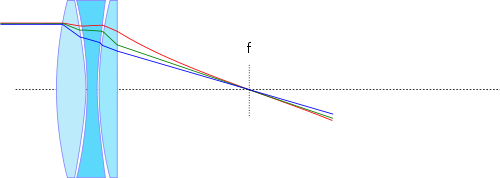Autofocusing technology has existed for a number of decades, dating back to 1970's with the
Konica C35 AF and later became a popular feature of consumer video cameras. Now autofocusing lens assembles can be had in
very inexpensive webcams available today. However, almost every readily available autofocusing camera features mechanically driven assemblies to move lenses with gears, a method inherently slow. Even more, current autofocusing lens assemblies can only provide a picture that is relative to the rest of the optical assembly.
Image flaws become exceptionally problematic in telescopes. Refractive telescopic optical assemblies come in three common forms:
Singlet Lens
- includes a single double convex (DCX) lens
- able to bring a single narrow band of the color spectrum to focus at a single time
- often used in magnifying glasses
Achromatic Doublet Lens
- includes a double convex (DCX) lens, known as the crown and often a positive meniscus (PMns) or a plano concave (PCV) lens, known as the flint and is made of a different type of glass
- able to bring two medium color bands to focus at a time, most often red and blue, leaving green at a nearer focus
- most common form of beginning amateur level refractive telescope
Apochromatic Lens
- comes in a doublet form similar in layout to an achromat but made with a higher quality glass for low color dispersion, and also comes in triplet form featuring a double convex (DCX), double concave (DCV) and plano convex (PCX) lenses, each made of varying forms of glass with low color dispersion properties
- able to bring most of the visible color spectrum to focus at once
- found in most high-dollar refractive telescopes
Chromatic aberration in an image produced by a telescope, can be devastating for clarity. However, the rapidity of an electrically driven liquid lens, allows for such a dramatic increase in focusing rate that one could oscillate the focus of a lens at a comparable change rate observable on most LCD computer displays, making the oscillations imperceptible to the human eye . This would provide a view through a telescope that was in perfect focus at every wavelength and every depth within a given field as the lens rapidly oscillated the focus. As a second and possibly a primary benefit,
atmospheric distortion could potentially be minimized through this system as well, greatly limiting the "boiling-effect" one can see when observing an object such as the
Moon.
I hypothesize that a rapidly oscillating liquid lens will allow comparable seeing through even a simple singlet lens to that of an apochromatic assembly by the means described above.
Later today, I will update this post with an illustration example for the described system.
 |
| An illustration of the bending optical path with an oscillating tunable lens. Click image to animate. |



